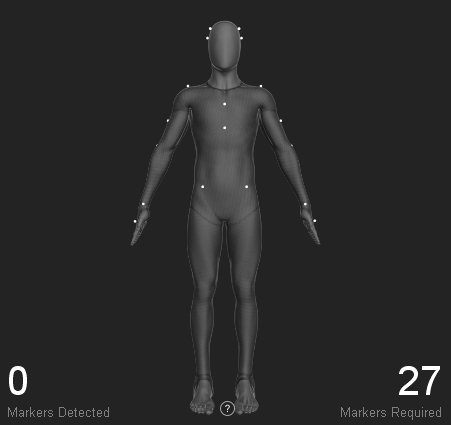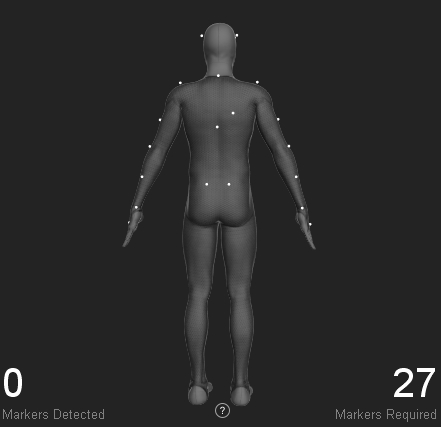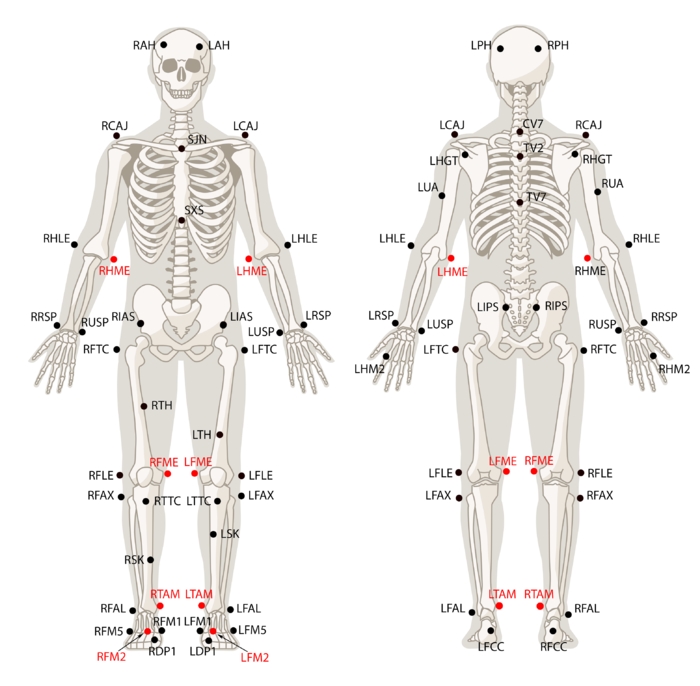Conventional Upper (27)
Conventional Upper (27)



Head Markers
LAH RAH
Head
Left Anterior Head Right Anterior Head
Place the markers on the left and right side of the fore head. The respective location is shown in the Skeleton figure.
LPH RPH
Head
Left Posterior head Right Posterior head
Place the markers on the left and right side of the head about 2 cm behind the ear. The respective location is shown in the Skeleton figure.
Torso Markers
SJN (IJ[1])
Thorax
Sternum Jugular Notch
Top most section of the sternum. Place the marker on the center of the two clavicle bones.
SXS (PX[1])
Thorax
Sternum Xiphoid Process
Lowest section of the sternum. Place the marker 1-2 cm above where bottom of the two rib cages conjoin.
CV7 (C7[1])
Thorax
Cervical Spine Vertebra 7
The 7th cervical spine vertebra is the largest vertebra located at the most inferior region of the neck. This section usually protrudes to the posterior side and can be palpated.
TV2 (T2[1])
Thorax
Thoracic Spine Vertebra 2
The second thoracic spine vertebra is located three spine levels below the C7 vertebra. Which is located approximately at same height with shoulder joint markers.
TV7 (T7[1])
Thorax
Thoracic Spine Vertebra 7
Usually located at the center of the thoracic spinal column.
Waist Markers
Pelvis
Left Iliac Anterior Spine Right Iliac Anterior Spine
Place the marker on the protruding bones located on the left and right side of the pelvis front.
Upper Extremity Markers
Thorax
Left Clavicle-Acromion Joint Right Clavicle-Acromion Joint
Ask the subject to stretch both arms towards the side (T-pose), then palpate top of each shoulder for the protruding bone. The prominence is usually located at the end of the corresponding clavicle bone just before where the upper arm starts.
LHLE RHLE
Upper Arm
Left Humerus Lateral Epicondyle Right Humerus Lateral Epicondyle
Placed the markers on the lateral side of the elbow axis. Flex and extend the arm few times to find where elbow axis is located.
LUA RUA
Upper Arm
Left Upper Arm Right Upper Arm
Ask the subject to stand in T-pose while placing the marker. Palpate to find the groove between the triceps muscles where skin movements are relatively minimal.
Not depicted in diagram
Forearm
Left Lower Arm Right Lower Arm
Place marker along the Ulna bone along the same line as the LUSP/RUSP marker
Hand Markers
LHM2 RHM2
Hand
Left Hand Second metatarsal Right Hand Second metatarsal
Place the marker slight below the knuckle of the index finger.
LUSP RUSP
Hand
Left Ulna Styloid Process Right Ulna Styloid Process
Place the marker on the lateral side of the wrist axis.
LRSP RRSP
Hand
Left Radius Styloid Process Right Radius Styloid Process
Place the marker on the medial side of the wrist axis.
References
Leardini, A., Biagi, F., Merlo, A., Belvedere, C., Benedetti, M.G., 2011. Multi-segment trunk kinematics during locomotion and elementary exercises. Clin. Biomech. 26, 562-571.
Leardini, A., Sawacha, Z., Paolini, G., Ingrosso, S., Nativo, R., Benedetti, M.G., 2007. A new anatomically based protocol for gait analysis in children. Gait Posture 26. 560-571.
Was this helpful?

